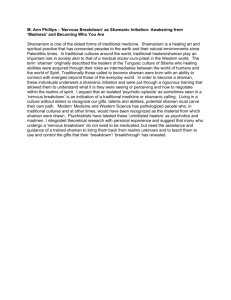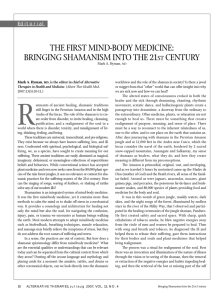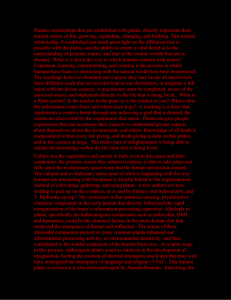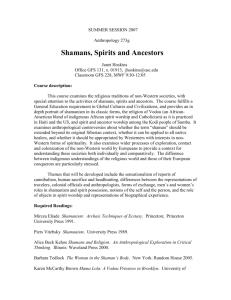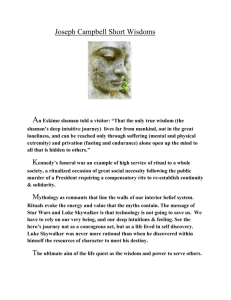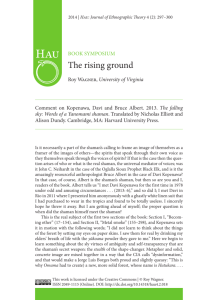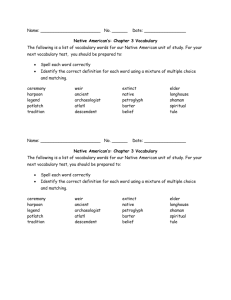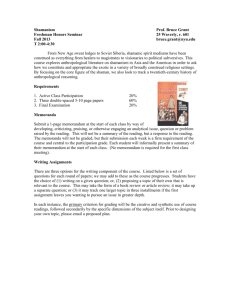m5zn_179bade057a8509
advertisement
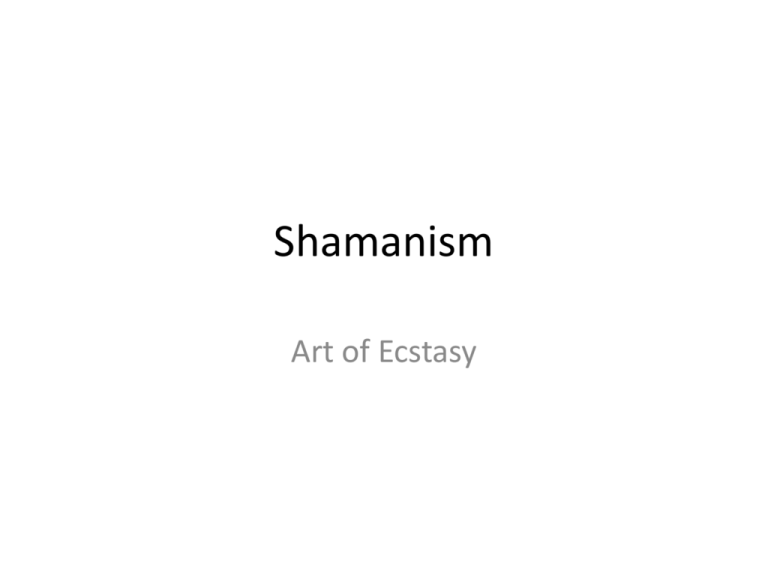
Shamanism Art of Ecstasy Shamanism • Shamanism is a range of traditional beliefs and practices that involve the ability to diagnose, cure, and sometimes cause human suffering by traversing the axis mundi and forming a special relationship with, or gaining control over, spirits. Shamans have been credited with the ability to control the weather, divination, the interpretation of dreams, astral projection, and traveling to upper and lower worlds. Shamanistic traditions have existed throughout the world since prehistoric times • Shamanism is a practice that involves a practitioner reaching altered states of consciousness in order to encounter and interact with the spirit world • Shamanism is based on the premise that the visible world is pervaded by invisible forces or spirits that affect the lives of the living • Shamanism encompasses the premise that shamans are intermediaries or messengers between the human world and the spirit worlds. • Shamans are said to treat ailments/illness by mending the soul. Alleviating traumas affecting the soul/spirit restores the physical body of the individual to balance and wholeness. • The shaman also enters supernatural realms or dimensions to obtain solutions to problems afflicting the community. • Shamans may visit other worlds/dimensions to bring guidance to misguided souls and to ameliorate illnesses of the human soul caused by foreign elements. • The shaman operates primarily within the spiritual world, which in turn affects the human world. The restoration of balance results in the elimination of the ailment Shaman • Shaman are spiritual beings with the ability to heal, work with energies and 'see' visions. The essential characteristics of shaman are mastery of energy and fire as a medium of transformation • A shaman is a person regarded as having access to, and influence in, the world of benevolent and malevolent spirits, who typically enters into a trance state during a ritual, and practices divination and healing. • “Shaman” is an umbrella term used by anthropologists to describe a vast collection of practices and beliefs, many of which have to do with divination, spirit communication, and magic. In most indigenous cultures, including but not limited to Native American tribes, the shaman is a highly trained individual, who has spent a lifetime following their calling. One does not simply declare oneself a shaman; instead it is a title granted after many years of study. The Anthropological History of Shamanism • It is the oldest form in which humanity has sought connection with creation. It is the oldest way of healing the individual, dating back as far as to the Stone Age. • Aspects of shamanism were encountered in later, organised religions, generally in their mystic and symbolic practices • There is a strong shamanistic influence in the Bön religion of central Asia, and in Tibetan Buddhism • The term "shamanism" was first applied to the ancient religion of the Turks and Mongols, as well as those of the neighboring Tungusic and Samoyedic-speaking peoples • Various archaeologists and historians of religion have also suggested that shamanism may have been a dominant prereligious practice for humanity during the Palaeolithic • • • • • According to an article by Dr. Frank Brownin the peer reviewed journal Nature (February 17, 2005) the modern human (homo sapiens sapiens) appeared on the planet at about 198,000 years ago. From that point until now there seem to have been very few changes in the basic human design. In other words a human from that time, dressed in our type of cloths would not warrant a second glance in any major city on the globe. In addition the size of the brain remained constant over the last half a million years as well. But there was one very important difference, our ancestor apparently had no culture. This means essentially no writing, religion, music, or cultural story. That is at least the theory as they left absolutely no evidence of such until over a hundred thousand years had passed by. Our first evidence of any repute of culture is at about 77,000 years ago when the first archeological evidence surfaced in Blombos cavern South Africa showing “symbolic” art (as opposed to just tools and weapons). This indicated that homo sapiens was finally starting to acquire one of the first elements of culture, art. But the first evidence of actual widespread culture came at between 40,000 and 50,000 years ago. Here we have evidence on the caves in Southwest Europe and closely followed by Africa. It was no coincidence that at this very time there was a mass exit or migration of our ancestors out of Africa. Because as the so called symbolic nature of art began showing, something major had happened to Homo sapiens at just this time. It is highly unlikely that this “culture” just happened. It could have just as easily have happened at anytime starting at about 200,000 years ago when our race emerged in its modern form. Why did it wait until 40,000 or 50,000 years ago? I’ll give a simple answer; shamanism. At this point or maybe a few years earlier, humans started to practice the art of shamanism and so started leaving records of this major paradigm shift in their evolution The late ethnobotonist Terrance Mckenna had a theory that went like this; at some point in our history (around 40,000 to 50,000 years ago as per above), a new leader appeared, called the tribal shaman • The shamanic practices of many cultures were virtually wiped out with the spread of Christianity. In Europe, starting around 400 CE, the Christian church was instrumental in the collapse of the Greek and Roman religions. Temples were systematically destroyed and key ceremonies were outlawed. Beginning with the middle ages and continuing into the Renaissance, remnants of European shamanism were wiped out by campaigns against witches. These campaigns were often orchestrated by the Catholic Inquisition. The repression of shamanism continued as Christian influence spread with Spanish colonisation. In the Caribbean, and Central and South America, Catholic priests followed in the footsteps of the Conquistadors and were instrumental in the destruction of the local traditions, denouncing practitioners as "devil worshippers" and having them executed. In North America, the English Puritans conducted periodic campaigns against individuals perceived as witches. More recently, attacks on shamanic practitioners have been carried out at the hands of Christian missionaries to third world countries. As recently as the nineteen seventies, historic petroglyphs (prehistoric rock drawing) were being defaced by missionaries in the Amazon. It has been postulated that modern state campaigns against the use of psychedelic substances are the offshoot of previous religious campaigns against shamanism. Today, shamanism, once universal, survives primarily among indigenous peoples. Shamanic practice continues today in the tundra’s, jungles, deserts, and other rural areas, and also in cities, towns, suburbs and shantytowns all over the world. This is especially widespread in Africa as well as South America, where "mestizo shamanism" ( combined ancestry) is widespread. Decline in modern society. • There are very small number of people who still practice Shamanism today. • Those that still do either feel rejected or ignored by there own communities. • Today, shamanism survives primarily among indigenous peoples. Ex: Jungles, tundras, deserts and shanty towns. • A unique approach to shamanism is that of Michael Harner, author of The Jivaro, Hallucinogens and Shamanism, and The Way of the Shaman. Dr. Harner is a former professor of anthropology at the New School for Social Research, and is currently acting as the director of the Center for Shamanic Studies. Sam-an ‘The One Who Sees’ 1785 Oshir 1905 2004 10 Shamanism around the world Several continents and countries within them practice shamanism. Countries such as: - Siberia China Korea Japan Cyprus Panama Brazil Peru Ecuador Continents such as: - Europe - Asia - Africa - North America - South America Origins • • • • Shamanism was the first organized religion. It was created in the paleolithic era. There is no specific date to when it began. The word Shaman is a Turkic word that translates to practitioner. • Origins of Shamanism: – Stone Age • Neanderthals – Archaeological evidence • The Celts, as a basic universal religion Believe or not • Shamanism is not a Belief System it is A technique not a religion Shamanism is the about being connected with nature, understanding that we are earth-based, the real and living knowledge which is then used for balance, health, relationship as well as success in all that is that we do. By understanding the word “shamanism” we would know that it is one of the oldest tribal healing traditions of indigenous people, which can be found in many different cultures worldwide. As well as many other methods, the one thing they have in common is communication and interaction with the spirit world. It is the oldest way in which human race has sought connection with Creation. • Shamanism is the path to knowledge which is gained through experience of many aspects of life, such as rituals, ceremonies, prayer and meditation, trials and tests. It is the practise, or discipline of interconnectedness and unlimited potential; which can create a total transformation of self. Shamanism is not a religion, not unless you want to make it into one. It has been and is being practiced by peoples of many religions, from Christianity, to Judaism, to Hinduism. You will find shamanic practitioners of every faith Mechanism • The shaman's power essentially lies in mastering the ecstatic techniques of dreams, visions, and trances. Ecstasy in its original sense meant an altered state of consciousness with an awareness of the single emotion rapture. The shaman also mastered the traditional mythology, genealogy, belief system and secret language of the tribe as well as its healing methods. The youth who are called to be a shaman attracts attention through their love for solitude, desire to roam in the woods or in unfrequented places, visions, and spontaneous song-making. Sometimes they enter trance-like states which make them unconscious. These signs are regarded with pleasure and awe by the tribespeople who generally believe that their soul is being carried away by spirits to a place where they are instructed, sometimes by his shaman ancestors, in the secrets of the profession. • • • Shamans work with the spirit or the soul. They heal illness at the soul level. They gain knowledge and insight from working with the spirits of nature such as rocks and trees, the land, and they gain knowledge from working with spirits of animals and humans such as their ancestors. For the shaman everything is alive and carries information, you can call this spirit, energy, or consciousness In order to communicate with the spirit or consciousness of these things, the shaman will shift his or her own state of awareness. Shamans can do this through various means, such as meditation, repetitive sounds such as that of the drum or rattle, or through the help of plants. The shaman will then "see" through a new set of eyes, they will see what is going on with you on a spiritual level. The shaman's practice is also characterized by the soul flight. The shift of consciousness that the shaman makes, which allows the free part of his or her soul to leave the body. The shaman can then go retrieve information for your healing and growth. They can retrieve healing power, or things that you have lost along the way in living your life. During the soul flight the shaman is both in the room, and going on this "journey" so that he or she has an awareness of both at the same time. More about the soul flight or journey. The shaman sees illness as a lack of power because it was lost somewhere in your life. In order to heal you the shaman returns your power to you. She or he may perform a power animal retrieval, see link for more details. A power animal is a protector, similar to a guardian angel, which protects you from harm and helps you with your spiritual growth by lending its power to you. • • • The shaman also removes misplaced energy. The negative emotions you may feel, or the negative emotions that another can send at you are seen by the shaman to be stuck or stored in various parts of the body. This can be seen with the example such as how stress causes ulcers or back pains. The shaman will re-empower you by removing the energy that does not belong within your body. This is called a shamanic extraction, other healing modalities in addition to shamanism practice this in various forms. This energy is not bad, it is just misplaced. Because it does not belong in your body, it is seen as causing illness that then shows itself in a physical way through pain, sickness or emotional difficulties. In the shamanic system part of the soul is free to leave the body, so therefore it is also believed that soul parts of each individual will leave the body in order to protect itself from trauma. This is considered a positive protection mechanism. For instance, if someone were to be in a car accident, part of the soul would leave the body to protect itself from the trauma of the impact. The soul does not always know how to return, however, and if it has not returned for whatever reason this is referred to as soul loss. That is when the shaman would become involved, in order to assist with returning this missing piece of yourself. The healer would perform a soul retrieval, see link for more information. In indigenous cultures this was performed quite regularly. In these modern times, a person may go a long time feeling like a part of him or herself has been missing. Most of the techniques of a shaman are particular to the individual or culture. Whether a rattle or a drum is used is not considered an essential difference for effectiveness. The shaman must do what ever he or she finds effective to call forth the energy for healing. Whatever the shaman does to shift his consciousness, must only achieve the results of shifting consciousness. The trappings of what the shaman does is comparable to how a star athlete prepares for a game, whether they do calisthenics to prepare, or simply rub their lucky sock, these preparations are just the trappings around the work itself. Once again it is the results that measure the skill level. Therefore there can be a wide variety of tools and techniques used by shamans, although certain tools/techniques appear frequently. The Shamanic Cosmos Upper World Middle World Lower World 17 Practice and method • • • • The shaman plays the role of healer in shamanic societies; shamans gain knowledge and power by traversing the axis mundi and bringing back knowledge from the heavens Oftentimes the shaman has, or acquires, one or more familiar helping entities in the spirit world; these are often spirits in animal form, spirits of healing plants, or (sometimes) those of departed shamans While the causes of disease are considered to lie in the realm of the spiritual, being effected by malicious spirits or Witchcraft, spiritual methods as well as what we would consider physical methods are used to heal. The shaman often will enter the body of their patient to find the spirit making the patient sick, and heal by removing the infectious spirit by the patient. Shamanism is based on the premise that the visible world is pervaded by invisible forces or spirits which affect the lives of the living. Although the causes of disease lie in the spiritual realm, inspired by malicious spirits, both spiritual and physical methods are used to heal. Commonly, a shaman "enters the body" of the patient to confront the spiritual infirmity and heals by banishing the infectious spirit • However, many shamans have expert knowledge of the plant life in their area, and an herbal regimine is often perscribed as treatment. In many places, the shamans claim to learn from the plants directly, only being able to determine the effects of a plant and use it to heal after meeting the spirit of the plant and getting permission • The use of totem items such as rocks is common; these items are believed to have special powers and an animating spirit • In engaging in this work the shaman exposes himself to significant personal risk, from the spirit world, from any enemy shamans, as well as from the means employed to alter his state of consciousness. Certain of the plant materials used can kill, and the out-of-body journey itself can lead to non-returning and physical death; spells of protection are common, and the use of more dangerous plants is usually very highly ritualized • Shamans gain knowledge and the power to heal by entering into the spiritual world or dimension. Most shamans have dreams or visions that tell them certain things. The shaman may have or acquire many spirit guides, who often guide and direct the shaman in his/her travels in the spirit world. These spirit guides are always present within the shaman though others only encounter them when the shaman is in a trance. The spirit guide energizes the shaman, enabling him/her to enter the spiritual dimension. The shaman heals within the spiritual dimension by returning 'lost' parts of the human soul from wherever they have gone. The shaman also cleanses excess negative energies which confuse or pollute the soul. • Shamans act as mediators in their culture. The shaman communicates with the spirits on behalf of the community, including the spirits of the deceased. The shaman communicates with both living and dead to alleviate unrest, unsettled issues, and to deliver gifts to the spirits. Shamans assist in soul retrieval. In shamanism it is believed that part of the human soul is free to leave the body. The soul is the axis mundi, the center of the shamanic healing arts. Shamans change their state of consciousness allowing their free soul to travel and retrieve ancient wisdom and lost power. Some of the methods for effecting such altered states of consciousness are: • Drumming • Singing • Fasting • Sweat lodge • Vision quests /or vigils, • Dancing or Spinning Games Power Plants • Tobacco • Fly Agaric • Psychedelic Mushrooms • Peyote • San Pedro • Ayahuasca Quechua for "Vine of the Dead" • Iboga • Cannabis • Opium Paraphernalia - Shamans use several different objects such as: A drum Feathers Rattle Gong Pipe Sword Long Table Shake Rooster Illness treated by shaman • • • Shamanic Healing addresses the spiritual aspect of illness. That is to say, it addresses the part of the illness that is in your spirit, soul, or energy body. Shamans believe that illness/injury appears in this spirit before it shows up in the physical body, and that if the body is injured the injury will also exist on the level of the spirit. Shamans believe that healing on the spiritual level can prevent conditions from appearing in the body, and also that healing the spirit helps or allows the body to heal once a condition has appeared. Unlike western medicine, the way the spiritual illness effects the body is not always the same. The way to address the same condition may be totally different from one client to the next. The "one method/one pill cures all" idea doesn’t work in shamanism. There is a mysterious element to how the shaman effects a cure. The shaman cannot say in advance whether the healing will work or not. Shamanic healing has effected cures on many different types of conditions. It is capable of addressing any illness. However, there is a difference between healing and cure. Healing occurs on many levels: in the emotions, in the body, in relationships with others, and in relationship to the planet. A cure is one dimensional, you have an illness and a cure eliminates it. Cures do not address your sense of well being, or whether your life is rich and full of power. Shamans seek to perform healing which may also result in cures • So a percentage of the people in the placebo group will improve even though they have not been given “real” medicine. This is called the placebo effect. Scientists are not sure why the placebo effect works. Is it the power of belief? Is it because of the medical attention the patient receives when they partake in a study? A shaman’s explanation for this would be that belief in the placebo helped the individual engaged with her own power to heal herself. In other words the patient recovers on the placebo because he is connected with his own power of self healing. Your body, your spirit, your soul can heal itself. • What is going to engage that healing action within you? • That is in part what shaman’s are trying to engage, your own healing abilities. Shaman’s certainly do work on the spiritual level, clearing out blockages and returning lost power, but one of the aims of healing is to connect clients with the power that is inside themselves. Shamanic Journey from to Normal Reality with → ← Extraordinary Realities questions → ← for Answers but… what about the journey itself? The Journey • http://www.shamanlinks.net/Journey.htm • leave ordinary reality to travel to extraordinary realities • return with knowledge Roles • • Shamans have two main roles in there societies. They are: - Healer Always present within a shaman. • They use there powers to heal those in need. • They cleanse souls • - Mediator They comunicate with the spirts of the deceased. • The spirits are seen as different beasts. • Shaman use there power to fix unresolved issues. Roles and functions the traditional shaman • divining information, wisdom, and knowledge from the ordinary and nonordinary worlds leading ceremonies • acting as an intermediary between the invisible spirit world and the people to restore health, drive out evil spirits, and ensure success in the hunting, gathering, and agricultural endeavors • preparing the people for hunting, gathering, and agriculturalefforts • communicating with the spirits and divining guidance about hunting, gathering, and agricultural matters foreseeing the future recognizing and reading signs and omens • officiating rites of passage, training, and ceremonies locating and bringing back wandering souls • retrieving lost power and soul parts • communicating with the dead • influencing the weather • channeling life-force, spiritual, elemental, and personal energy through their hands-on healing • removing possessing spirits, evil spirits, and souls who have not crossed over from a person, family, group of people or place • performing sacrifices to appease the spirits and the gods • using plants, plant energies, and plant spirits for healing purposes • talking to nature spirits, such as the helping spirits of plants, animals, rocks, water, and weather elements • singing songs to invoke, connect with, and honor helping spirits • singing healing songs • diagnosing illnesses • learning and exploring universal laws and the ways of energy and power • teaching apprentices and the people certain spiritual ways • setting bones, pulling teeth, treating wounds • adjusting the physical body using techniques such as massage and manipulation (similar to adjustments done by an osteopath or chiropractor) • interpreting dreams Initiation • However it is precisely because they succeed in curing themselves that these individuals become shamans. Often a crisis bordering on madness is provoked in the future shamans by the sudden announcement to others in the tribe that they have been chosen by the spirits for this profession. In other cases this initiatory sickness is induced by the use of drugs or fasting and other austerities. Regardless of the means, the symbolic pattern of death and rebirth common to all initiation rites will be reenacted. • The initiatory rituals peculiar to Siberian and central Asian shamanism include a ritual series of waking dreams. During this ritual Siberian shamans maintain that they "die" and lie inanimate for from three to seven days in a tent or other solitary place: • Turner and colleagues mention a phenomenon called shamanistic initiatory crisis, a rite of passage for shamans-to-be, commonly involving physical illness and/or psychological crisis. The significant role of initiatory illnesses in the calling of a shaman can be found in the detailed case history of Chuonnasuan, the last master shaman among the Tungus peoples in Northeast China. • The wounded healer is an archetype for a shamanic trail and journey. This process is important to the young shaman. S/he undergoes a type of sickness that pushes her or him to the brink of death. This happens for two reasons: 1) The shaman crosses over to the under world. This happens so the shaman can venture to its depths to bring back vital information for the sick, and the tribe. 2) The shaman must become sick to understand sickness. When the shaman overcomes her or his own sickness s/he will hold the cure to heal all that suffer. This is the uncanny mark of the wounded healer • One does not simply choose to be a shaman. In many cultures, a person is only trained to be a shaman after experiencing a specific event which indicates their connection with the spirit world. In some cases, the prerequisites are certain types of dreams. These cultures place a lot of value on dreams as a connection between the spirit world in general, and much of a shaman's connection with the spirit world is through dreaming. • Another indication of a shaman's abilities is surviving a deeply traumatic,( near-death experience), something that would change the person's behavior and outlook throughout his life. It is understood that such a person would have gained a glimpse of the spirit world and perhaps that it the spirits who allowed him to return. • After displaying one of these experiences, a shaman is generally trained under a more experienced shaman for many years to understand the lore and rituals, as well as how to more safely travel the spirit world. In some cases, the training comes first, without a specific experience marking the potential shaman. In this case, at some point the trainee will still need to have such an experience, although it might be brought on by ecstatic trance work or through chemical means Becoming a Shaman • shamanic call • study and initiation • learning to journey • death of the old person, and rebirth as a new person So You Want to be a Shaman • be prepared to “die” • be willing to serve others • be open to experiences that most people do not want to face • In some societies shamanic powers are considered to be inherited whereas in others shamans are considered to have been "called“ • Shamans are normally "called" by dreams or signs which require lengthy training. However, shamanic powers may be "inherited," as the capacity for lucid spirit-world connection runs more strongly in some families Gender • Most shamans are men, but there are societies in which women may be shamans • Both male and female shamans can be found throughout the world. However, each tribe has its own understandings of who is an appropriate shaman. Some allow both genders, while some have only one or the other. Some allow both but tend most often to have one or the other Shaman in the community • Position in the Community Some shamans are well integrated into the community, living among them day-today. Some even participate in other community roles, such as hunting, particularly in areas where the tribe needs everyone to contribute to basic physical survival. • Other shamans, however, are viewed as outsiders, living outside the main camp on his own, although often having as assistant or shaman-in-training with him. His contact with the spirit world makes him unlike the rest of the tribe. He is more a part of the wilderness, in many ways more animal than human. These isolated shamans survive on what they can forage as well as the payments received for their services. • Some shamans are seen as primarily beneficial, with their powers focused on bringing blessings to the community. Shamans in other cultures are viewed as having powers to both hurt and heal. This is particularly the case when shamans live more isolated from the community. In these cases, shamans often offer protection from the possible curses of other shamans. If the tribe can be convinced of a shaman's magical actions against the community, he can be exiled or executed Believes • Spirits exist and they play important roles both in individual lives and in human society. • The shaman can communicate with the spirit world. • Spirits can be benevolent or malevolent. • The shaman can treat sickness caused by malevolent spirits. • The shaman can employ trance inducing techniques to incite visionary ecstasy and go on vision quests. • The shaman's spirit can leave the body to enter the supernatural world to search for answers. • The shaman evokes animal images as spirit guides, omens, and message-bearers. • The shaman can tell the future, scry, throw bones/runes, and perform other varied forms of divination A female shaman leading an initiation for novices outside Ulaanbaatar holds up the heart she has just removed from a sheep. She sees this sacrificial offering as a symbol of her power over life and death animal spirit painted rock Drums At night in her tepee-like ortz, Sain Tsetseg (Good Flower), of the Tsaatan ethnic group, beats a drum to enter a trance while an assistant burns juniper twigs, whose fragrant smoke draws in the spirits Symbol of eternity, this “mother tree,” a pine in northern Mongolia, draws pilgrims from all over. It gave out under the weight of cloth offerings, the blue ones representing everlasting heaven and peace Shamanic meeting hollow bone tool for extraction work Pilgrims from throughout Mongolia come to mother trees like the one near Selenge Aymag, in the north, to offer tea, milk, symbolizing their prayers and the blessings they seek Archaeologists have unearthed nearly 5,000-year-old shaman's stones in a rock shelter in Panama. The stone collection may be the earliest evidence of shamanic rituals in that region of Central America. Remains of Ancient Feast to Honor Dead Shaman Discovered In a cave above a creek in the Galilee region of northern Israel, scientists discovered the body of a petite, elderly, disabled woman, most probably a shaman, and also discovered seashells, beads, stone tools and bone tools Israel: Oldest Shaman Grave Found; Includes Foot, Animal Parts A 12,000-year-old burial site in Israel contains offerings that include 50 tortoise shells and a human foot, and appears to be one of the earliest known graves of a female shaman. Deep in the Amazon jungle, writer Kira Salak tests ayahuasca, a shamanistic medicinal ritual, and finds a terrifying but enlightening world within. or centuries, Amazonian shamans have used ayahuasca as a window into the soul. The sacrament, they claim, can cure any illness. The author joins in this ancient ritual and finds the worlds within more terrifying - and enlightening - than ever imagined. 53 Stone age
